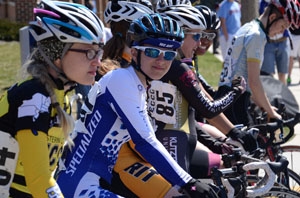On the road: A cyclist’s perspective
Penn State cyclist Carren Stika started competing in bike races as an amateur during her freshman year of college. Stika dedicated herself to the sport and is now a competitive racer in the top category of women’s collegiate cycling.
Stika trains hard to build the endurance she needs to gets through 50 mile-long road races. Her practice rides can last between 20 to 60 miles and take one to four hours — and she rides six days a week. She trains regardless of extreme heat or cold.
The spring semester is racing season, which means Stika spends most weekends competing at other universities. Racing for the Penn State Club Cycling team, she travels as far away as Worcester, Mass., and Providence, R.I., to compete. Stika competes in road races, circuit races and hill climbs.
As athletes in a club sport, cyclists receive no scholarships from the university. Often, they sink their own dollars into purchasing the best equipment. It’s their love of the sport that drives them, she said.
Stika just got a new race bike. 
“As you race and improve, you start racing against girls who have better equipment than you. You need to update your equipment to match your competition,” Stika said.
A longtime track and field competitor, Sticka needed a new sport to fill the athletic void after she wasn’t recruited for the team at Penn State. One of the girls who lived on the same floor in her residence hall freshman year competed in cycling races. Stika soon took up the sport.
She said she received a hybrid bike as a graduation present that she thought she could modify and race. She quickly realized that she needed a road bike to be a serious competitor, and she built up her own road bike her freshman year. Some of the guys on the team helped Stika as she got started, but she is mostly self-taught, she said.
About 40 cyclists participate on race weekends; few of them are women. As the team’s women’s coordinator, Stika serves as a mentor to four or five other women. Stika can often be found on the course cheering on less-experienced women’s racers from the sidelines or sharing words of encouragement with other women in her class after they finish.
Kasinee Gehring is in her first year of road biking. Gehring, a sophomore studying kinesiology, said she came to a cycling club meeting without knowing anyone. Stika came over to her and welcomed her, and Gehring is now part of the team.
“It has made my experience, really, a lot better, and I feel really comfortable on the team,” Gehring said. “It’s hard sometimes, but I really enjoy it.”
Stika has come a long way since she joined the club and began racing. She first raced in the introductory category in the spring of 2010, her freshman year. Now, a senior Stika competes in the Women’s Class A — a goal she achieved last year. Racers must complete at least 10 races and finish in the top 10 in all of them before upgrading from Class B.
In a photo finish, Stika won second place in a criterium race at Shippensburg University on April 6. Twenty-seven women competed in the race. She hopes to finish the season in the top 10 of the Women’s Class A in the conference’s overall standings.
The shaved-leg challenge
Cyclists like to have hairless legs for two reasons, Stika said. It keeps their skin from sticking to the pavement if they crash, and they believe it makes them more aero-dynamic, she said. That's lead to a friendly competition between Stika and the male cyclists for the honor of the best-shaved legs.








